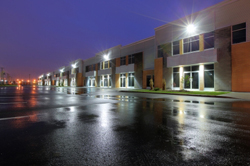|
Home: Outdoor HID Lighting
Putting Outdoor HID Lighting To Good Use
There are different types of HID lights which can be separated into four main categories: Mercury Vapor, Metal Halide, High Pressure Sodium, and Low Pressure Sodium. HID lamps, also known as high intensity discharge lamps produce light by sending an electric arc through a gas filled chamber. The electric arc reacts with the gas, exciting it resulting in the visible light you see. The type of gas used changes based on the lamp type which influences the lamp's color output, lifespan, and efficiency. Choosing the right ballast along with the commercial outdoor lighting fixtures best suited for your HID lamps is important to get the most out of your HID lighting.
Color Output The color output an HID light produces reflects the actual color output the gas within the lamp releases when it's excited. The color is dependent on on two things: the type of gas used within the bulb's glass chamber and the lamp's phosphor coated interior surface. Not all outdoor HID lighting is phosphor coated. A phosphor coating on the inside of the glass bulb is used by manufacturers to change the color output of an HID Lamp. For example, a mercury vapor lamp that typically produces a blue-green light output could be manipulated by adding a red phosphor coating to the inside of the glass tube. This coating would change the color output that the lamp emits as visible light when it reacts with the light output produced by the mercury vapor gas.
Types of Outdoor HID Lamps
As we mentioned earlier, there are four different kinds of outdoor HID lamps. All of which are commonly used in commercial outdoor lighting applications. Each one of these has it's own distinct qualities or as I like to call them, personalities. They all work the same way by sending an electric arc through a gas filled tube.
Mercury Vapor HID Lighting These HID lamps use, you guessed it, mercury vapor gas so that when the gas is ignited by the electrical arc it produces a blue-green light output. The lifespan of a mercury vapor lamp is very long, sometimes up to 24,000 hours. Some manufacturers use a phosphor coating on the bulb's interior surface to change the lamp's color output. The downside to mercury vapor lamps is their large size and limited availability, making them less popular and harder to find than other HID lamps.
Metal Halide HID Lighting Metal halide lamps also use mercury vapor gas but what distinguishes them from mercury vapor lamps is the small quantities of metal halide inside the lamp. These halides assist the lamp in producing a nice white color, often referred to as the best white color of all the HID lights available. The halides however shorten the lamp's lifespan. The challenge with these lamps is the small color differences between other metal halide lamps. When seen independently the color output of each lamp looks the same, but when seen together you may be able to see slight differences in color output from lamp to lamp. This is due to the manufacturing process and the amount of halides used in each lamp. The voltage produced by the ballast supplying power to the lamp can also influence color output.
High Pressure Sodium HID Lighting High pressure sodium lamps use sodium vapor gas to produce light. The high pressure part of the equation comes into play in the manufacturing process. The manufacturer will increase the amount of gas pressure housed within these lamps giving these outdoor HID lights a golden yellow color. These commercial outdoor lamps enjoy a long lifespan and are very efficient to operate. Often you'll see these lamps used in parking lots and highways. You can find color improved high pressure sodium lamps, but their lifespan is significantly reduced.
Low Pressure Sodium HID Lighting As you guessed it, low pressure sodium lamps use sodium vapor gas just like their big brother the high pressure sodium lamp. The only difference is that low pressure sodium uses much less gas pressure when compared to high pressure sodium lamps. This lower pressure creates a very, very yellow light output. While low pressure sodium lamps are very energy efficient, the color produced causes discoloration when reflected off of different surfaces.
|
FREE Newsletter Stay up-to-date with all the latest web updates, news, and outdoor lighting tips! Newsletter Form
|
|
|
|
Always consult with a licensed electrician before attempting any outdoor lighting work contained in this website.
Build your own site with Site Build It! | Copyright©2008 www.Creative-Outdoor-Lighting.com
Get your own custom template
 Outdoor HID lighting can be used for many outdoor lighting applications. Its one of those things that rarely gets noticed.
Outdoor HID lighting can be used for many outdoor lighting applications. Its one of those things that rarely gets noticed. 




